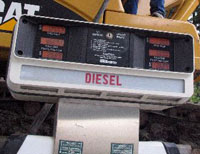Russia loses its diesel industry
Now 10 enterprises in Russia make ship diesel engines, and several tens enterprises specialize on manufacturing the accessories. From the point of view of the legal status practically all diesel making enterprises were transformed into open JSCs, which for many years have been working isolated from each another, trying to survive in the conditions of the general stagnation of the industry. Some of them did not survive the loss of orders and ceased their existence: former Nobel Plant «Russian Diesel»; as well as the constructed in 80–90s JSC «Leningrad Diesel Plant». Besides, JSC Pervomaiskdiesel (Ukraine), which in soviet times used to make medium RPM engines disappeared too.

Therefore now in Russia without the above mentioned enterprises a free niche in the market of powerful medium RPM diesel engines has been formed. Here JSC "RUMO" and JSC «Kolomna Plant» accelerated their activities, but the latter tends to specialize on locomotive diesel engines of the type D49. There is a similar situation in the market low-power (below 100 kWt) high RPM ship engines. Without "Yuzhdieselmash" left abroad (in the Ukraine) and JSC «Riga Diesels» (which stopped making diesel engines at all) now Russia has only JSC Dagdiesel, which makes the engines powered below 44 kWt. Very slowly JSC Barnaultransmash is entering this sector of the market on the basis of its automobile diesel engine VAZ-3415 with the power of 34 kWt. Therefore many Russian enterprises, trying to fill in the free niche, create ship updates on the basis of their automobile and auto-tractor diesel engines offering these engines to their untraditional consumers.
Seven out of ten plants make diesel engines in the range between 500 and 1500 kWt. Only three plants (BMZ, KTZ and Zvezda) have wider range, but not fully covering the needs of shipbuilding. At the same time successful foreign firms (MAN, Wärtsilä etc.) make engines of various power ranging from several to tens of thousand kWt, thus forming standardized engines’ families with versions unified on the design (from several tens up to several hundreds kWt), with different number of cylinders, different RPM, differently augmented, different compositions etc. It allows for constant and significant expansion of the range of the developed engines’ updates, growing output, faster pace of the development of the new engines and, most importantly, guaranteed use of them as power-plants on any industrial or transport object.
As of today Russia is not capable of manufacturing four-stroke diesel engines of the power range:
- medium RPM 3700 kWt (the main engines of big fishery ships, oil tankers, dry-cargo ships, tugs etc.);
- high RPM in the range from 44 to 118 kWt (auxiliary engines and emergency a diesel engine-generators for ships of all classes and purposes, main engines of river ships);
- high RPM below 5 kWt (engines of life boats, emergency diesel engine-generators).
According to our insiders the problem of medium RPM engines may be solved in the following ways (however, it remains hypothetical from the point of view of the policy of the government regarding the industry):
- expanding the power range of some ship diesel engines on the basis of the concept of double purpose engines (DDN) when creating ship diesel engines with the power of 8-10 thousand h.p. on the basis of the Kolomna engines sized ChN 26/26 and powered 4-5 thousand h.p. on the basis of Ural Diesel Motor sized ChN 21/21;
- when developing new types of engines meeting modern requirements: RUMO (ChN22/28), Barnaultransmash (series BMD ChN ChN15/18); modernizing existing designs of diesel engines for their application in shipbuilding: Ural Diesel Motor (ChN 21/21), Volga Diesel Maminyh (ChN 21/21).
In general technical parameters of the ship engines already reached allow for considering their use on the perspective ships keeping in mind engines’ profitability rate, opportunity of using fuels with high viscosity, good weight / size ratio and life time parameters. However, the parameters of the Russian made diesel engines from the point of view of harmful emissions in the atmosphere remain unsatisfactory. Russian diesel makers neglected this point, therefore now the use of their models on the ships of foreign navigation becomes more and more problematic (except for separate models of licensed diesel engines of BMZ and new developments of Kolomna Plant).
Keeping in mind a broad application of the diesel engines in the power units of the domestic ships, Russian naval organizations are interested in constant improvement of engines’ technical and economic parameters, the main of which are: fuel efficiency, reliability, durability, suitability for repair, simplicity of service, vibro-acoustic characteristics, weight and dimensions, ecological safety.
Numerous attempts of Russian diesel enterprises to create co-production with western diesel firms have not yet been successful. Purchase and attempt to arrange the manufacture of the engines under the licenses of foreign firms have not led to the planned results too. The reason is that foreign firms, as a rule, agree on transferring license documentation on the outdated types of engines, even forbidding the export of these engines outside Russia. The only exception is the Nizhny Novgorod based RUMO, which is arranging the production of the licensed engine 6 and 8 ChN 32/40 of the firms MAN B&W.
Read also 'Competitors beat Russia in the field of diesel industry'
Subscribe to Pravda.Ru Telegram channel, Facebook, RSS!



